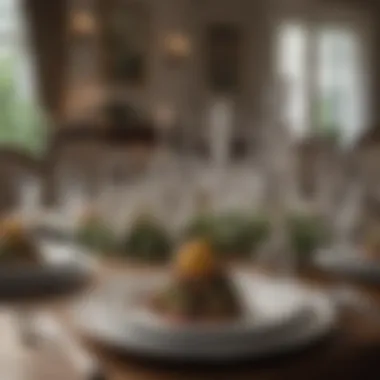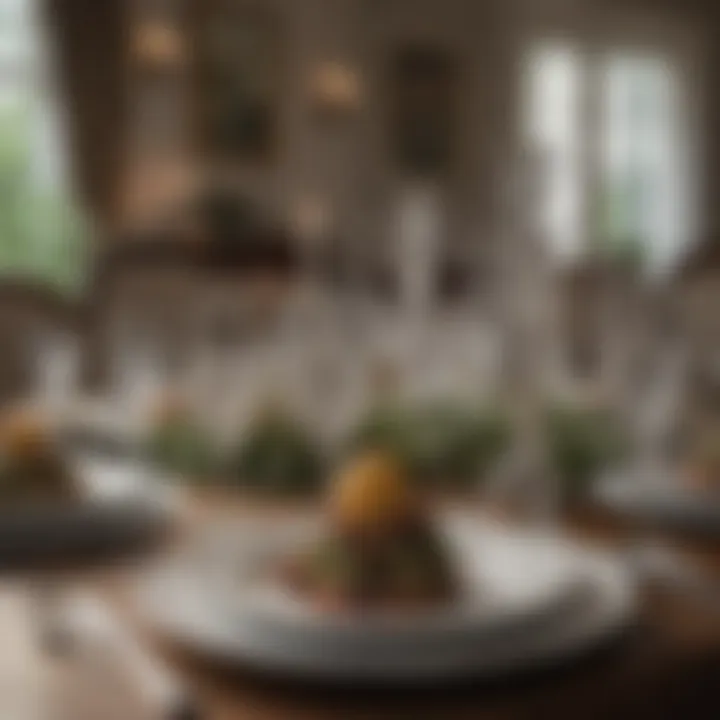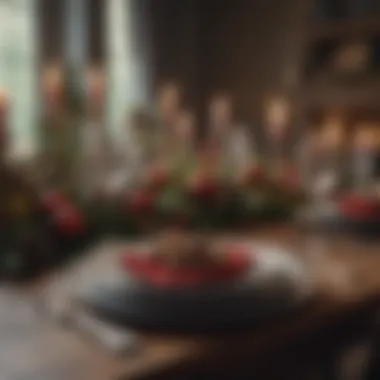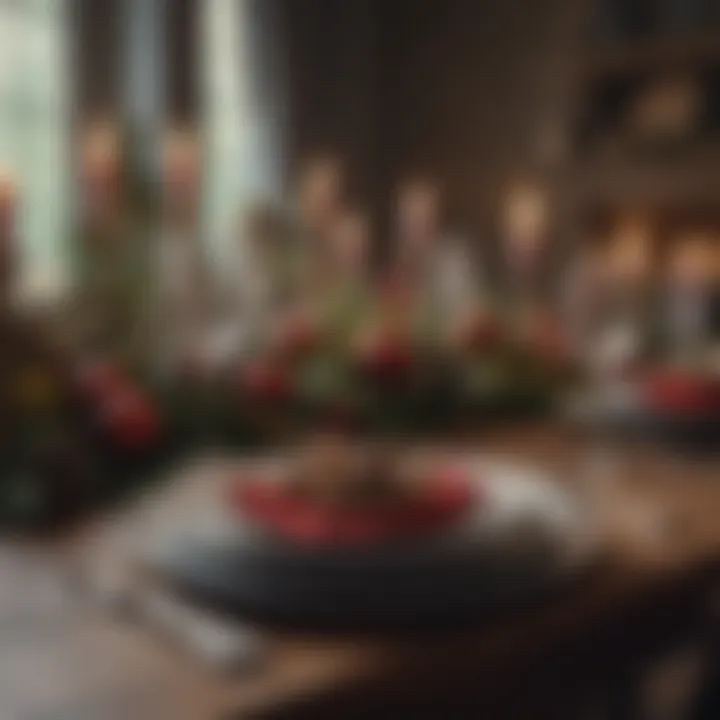Ultimate Guide to Setting a Dinner Party Table


Intro
Setting a table for a dinner party is an art form that combines aesthetics with functionality. This guide will navigate the various elements involved in creating an inviting and memorable dining experience. From choosing the right tableware to thoughtful arrangements and décor, every detail contributes to a cohesive atmosphere. Ultimately, the goal is to achieve a balance that delights the eyes while serving practical needs.
Understanding the nuances of table setting helps elevate dining occasions. Whether you're catering to an intimate gathering or a larger celebration, the principles discussed here can adapt to various themes and personal styles. Having a well-set table also enhances the overall ambience, making every guest feel appreciated and welcomed.
As we explore this topic, we will delve into essential aspects such as:
- Selecting tableware that complements the occasion.
- Implementing arrangement styles to enhance the flow of service.
- Incorporating décor considerations that reflect the theme and mood of the event.
Let’s begin with the featured homes that inspire our table settings.
Understanding the Basics of Table Setting
Table setting is more than just placing dishware on a table. It involves art, science, and subtle psychology. When thrown into the context of a dinner party, the significance of understanding basic table setting becomes paramount. A well-set table influences not only the aesthetic appeal but also the dining experience itself. It establishes the tone of the evening and enhances the comfort of the guests.
A thoughtfully arranged table communicates care and attention to detail. It can make even a simple meal feel special. In this section, we will dive into the essential components that form the foundation of an effective table setting.
The Importance of Presentation
Presentation can dramatically affect how guests perceive both food and atmosphere. On a psychological level, an aesthetically pleasing table can lead to increased satisfaction with the meal. When a table looks organized and welcoming, it fosters feelings of comfort among guests. They may enjoy their company more and even savor their food better.
Thoughtful presentation also acts as a conversation starter. The blend of colors, shapes, and styles can prompt discussions about culinary preferences, recent events, or even design inspirations. This interaction enhances the overall experience, making dinner parties not just a meal but an event to remember.
Key Components of a Table Setting
A well-considered table setting encompasses four main components: tableware, cutlery, glassware, and napkins. Each element has its own role and contributes to the overall ambiance of the dinner.
Tableware
Tableware refers to the plates and serving dishes used at a dining table. The choice of tableware is essential in creating an inviting atmosphere. Porcelain is often seen as a premier option due to its durability and elegant appearance. It comes in various designs, allowing flexibility in presentation.
Another option is stoneware, which tends to be sturdier and usually comes in rich, earthy colors. These characteristics make stoneware favorable for casual family gatherings. However, in a formal setting, tableware should align with the overall theme.
Cutlery
Cutlery includes forks, knives, and spoons. Each type of utensil has a specific role in the dining process. For example, a well-crafted stainless-steel knife is not only functional but also adds to the setting's elegance. Many prefer using sterling silver for formal dinners, which conveys luxury and sophistication.
It's essential to arrange cutlery properly. This arrangement facilitates ease of use, following a conventional outside-to-inside approach based on the progression of courses. An organized display reflects attention to detail and enhances the dining experience.
Glassware
Glassware extends beyond just wine glasses or water goblets. Different beverages often require specific types of glass. For instance, a red wine glass is shaped to enhance the flavor, while a flute is better suited for sparkling wines. Choosing the right glassware elevates the experience and indicates thoughtfulness in serving.
Placement is also key. Each glass should sit within easy reach yet not crowd the plate. Proper placement helps create an atmospheric balance, enhancing the visual appeal of the table setting.
Napkins
Napkins play a crucial role not only in practicality but also in aesthetics. They offer a space for guests to wipe their hands and mouths while also adding an element of style. Linen napkins, for instance, usually bring a sense of sophistication.
Folding techniques can vary significantly. Simple folds can be elegant on their own, while more intricate designs can serve as focal points in the setting. Proper integration of napkins into the overall table design illustrates a consideration for the guest’s experience.
"A well-set table speaks volumes about the host's attention to detail and hospitality."
Choosing the Right Tableware
Choosing the right tableware plays a significant role in setting the tone for a dinner party. The material, design, and style of tableware can influence not only the aesthetic appeal but also the dining experience itself. Appropriate tableware enhances food presentation and complements the overall decor. With countless options available, it is essential to carefully select items that embody functionality and visual charm, creating a harmonious atmosphere for guests.
Material Options
Porcelain
Porcelain is often hailed for its sophistication and durability. It has a smooth, fine finish that adds a touch of elegance to any table setting. One key characteristic of porcelain is its ability to retain heat well, thus keeping food warmer for longer periods. This feature makes it a beneficial choice for formal occasions where presentations are paramount.
A unique feature of porcelain is its versatility; it can be found in various designs, from classic white to intricate patterns. While porcelain is generally dishwasher safe, one disadvantage is its susceptibility to chipping if mishandled. Overall, its aesthetic appeal and practical attributes make it a favored choice for dinner parties.
Stoneware
Stoneware is another popular option, known for its robust nature and earthy qualities. It varies in color and texture, often having a rustic appearance that appeals to casual dining settings. One notable characteristic of stoneware is its heat retention, which ensures that dishes remain warm after being served.
Its unique feature is its ability to go from oven to table, making it functional and visually pleasing. However, it can be heavier and less refined than other materials. In informal settings, stoneware provides a charming ambiance while maintaining practicality, making it a viable choice for festive gatherings.
Melamine
Melamine is a practical option, especially for outdoor or casual gatherings. Its key characteristic is being lightweight and shatter-resistant, ideal for environments where accidents may occur. This aspect renders melamine a popular choice for families or events with children present.
A unique feature of melamine is its vibrant color options and patterns, which can invigorate any table setting. However, it is essential to note that melamine should not be used in the microwave, limiting its functionality somewhat. Overall, it offers a balance between aesthetics and practical use during less formal dining occasions.
Color and Pattern Selection
Selecting the right colors and patterns for your tableware can dramatically influence the overall tone of the dinner party.


- Personal Preference: Determine your overall theme or personal taste. Faded hues might work well for a muted, elegant affair, while vibrant colors could amplify a festive environment.
- Event Theme: Consider matching tableware colors to the event's theme or season. Autumn hues can bring warmth, while summer colors evoke freshness.
- Mix and Match: There is also the possibility of creatively combining different patterns and colors, establishing an eclectic yet sophisticated gathering atmosphere.
In this way, color and pattern selection extends beyond mere aesthetic choices, engaging guests in a visual experience that resonates throughout the dinner event.
Selecting Appropriate Cutlery
In the realm of table setting, cutlery plays a crucial role in both functionality and aesthetic appeal. Selecting the appropriate cutlery ensures that guests can enjoy a meal comfortably, while also enhancing the overall experience of the dinner party. The right utensils not only reflect the host's attention to detail, but also align with the theme and style of the gathering. By focusing on the types of cutlery to use and their proper arrangement, one can create a dining experience that is both engaging and practical.
Understanding Different Types of Cutlery
Forks
When discussing forks, it is essential to highlight their design and purpose. Traditionally, forks have two or more tines, which facilitate the easy spearing and handling of food. In formal settings, a variety of forks are often used, each serving a specific dish or purpose, such as the salad fork or dinner fork. Their versatility makes forks a beneficial choice for any dinner party.
One key characteristic of forks is their size and shape. This diversity allows for a tailored approach based on menu selections. For example, dessert forks are typically smaller, suitable for accompanying lighter fare like cake or pie. However, a disadvantage could be the need for multiple types, which may complicate the table setting.
Spoons
Spoons hold a prominent place among cutlery options and are vital for serving and consuming many dishes. With a rounded bowl, they can scoop liquids or soft foods, and they are often used for soups, cereals, and desserts. Their broad utility makes them a popular choice for dinner parties, providing functionality without sacrificing style.
The key characteristic here is the variety of spoons available, which includes soup spoons, dessert spoons, and tea spoons. Each type has a specific size and shape tailored for its intended use. However, one might consider the challenge of balancing the number of spoons needed against the intended courses, ensuring that all necessary utensils are present without cluttering the table.
Knives
Knives are designed primarily for cutting and slicing, making them indispensable for any dinner involving meats or hearty vegetables. The typical dinner knife has a smooth, sharpened edge that facilitates effortless cutting. A crucial benefit of including knives in the table setting is the variety they offer. This includes options such as steak knives or butter knives, each tailored to its specific purpose.
The unique feature of knives is their ergonomic design, which enhances ease of use during meals. However, an important consideration is safety; improper placement or sharp edges can pose risks. Therefore, it is vital to ensure that they are arranged correctly to avoid accidents.
Arranging Cutlery for Optimal Use
Properly arranging cutlery is essential for optimal use during the dinner party. Follow these guidelines:
- Outer to Inner Placement: Place utensils in the order they will be used, with those for the first courses furthest from the plate.
- Alignment: Ensure that all utensils are aligned with the table edge, creating a streamlined and elegant look.
- Spacing: Maintain space between each piece to prevent a cluttered appearance. Each setting should be comfortable for guests to access their utensils without overlap.
By adhering to these principles, one can enhance the dining experience, allowing guests to focus on the meal instead of the logistics of handling their cutlery.
Glassware Considerations
Choosing the right glassware is essential when setting a dinner table. This decision affects not only the overall aesthetic but also the functionality of the dining experience. The right glassware enhances the flavors of beverages, complements the food served, and contributes to an inviting atmosphere. An effective glassware selection provides a balance between beauty and practicality, making it an integral part of any dinner party setup.
Types of Glassware
Wine Glasses
Wine glasses are specially designed to enhance the tasting experience. They come in a variety of shapes, each catering to specific types of wine. The key characteristic of wine glasses is their shape, which affects how aromas are released. For instance, a bowl that is larger allows red wines to breathe, revealing their complexity. This is a popular choice when serving wine at dinner parties, as the right shape can enrich the tasting experience.
One unique feature of wine glasses is their stem, which allows guests to hold the glass without warming the wine with their hands. This prevents any change in temperature that could alter the flavor. However, wine glasses can be delicate and require careful handling, making them less convenient for casual settings.
Water Goblets
Water goblets serve a practical purpose in table settings. They are typically sturdy and come in a range of styles that can suit formal or casual occasions. The key characteristic of water goblets is their versatility; they can be used for water, soft drinks, or even light cocktails. This makes them a beneficial choice for gatherings where various beverages are served.
A unique feature of water goblets is their thicker glass, which makes them more durable than wine glasses. This durability offers an advantage in settings where casual dining takes place, as it reduces the risk of breakage. However, their robust design may not always align with more elegant table settings.
Specialty Glasses
Specialty glasses are tailored for specific beverages or occasions. This category includes cocktail glasses, shot glasses, and even dessert glasses. The importance of specialty glasses lies in their ability to elevate the drinking experience tailored to specific drinks. For instance, a martini glass enhances the presentation of a cocktail, making it an attractive choice for cocktail hour.
The key characteristic of specialty glasses is their distinct shapes and purposes, adding a decorative element to the table. These glasses are beneficial as they can help emphasize the theme of a dinner party. However, they may also add complexity to the table setting, requiring careful consideration regarding how many different types to use.
Strategic Placement of Glassware
The arrangement of glassware on the dining table should facilitate ease of access while maintaining aesthetic balance. Assessing the size of the table and the number of guests will guide the placement. Here are some useful tips for strategic placement:
- Position Glasses Closest to the Plate: Glasses should be positioned to the right of the setting. This ensures easy access for guests as they reach for their beverages.
- Group Similar Layouts: Consider using a matching set for similar types of glassware. It creates visual harmony and aids in avoiding confusion during service.
- Utilize Ample Space: Ensure there is enough space between each glass to prevent spills and allow guests to enjoy their drinks comfortably.
"Proper placement of glassware not only enhances the ease of dining but also elevates the overall presentation of the table."
In summary, engaging with the nuances of glassware is fundamental when preparing for a successful dinner party. The type and arrangement of glassware are not merely aesthetic choices; they influence the overall dining experience. By carefully selecting glasses and positioning them strategically, hosts can create a welcoming environment that enhances guest enjoyment.
Folding and Arranging Napkins
The arrangement of napkins is an essential element in setting a table for a dinner party. They serve both a practical and decorative purpose, enhancing the visual appeal of the table and providing function during the meal. The way napkins are folded and placed can indicate the formality of the occasion, adding an extra layer of sophistication or charm to the setting. Additionally, well-arranged napkins can mitigate spills and create a more inviting atmosphere for guests. Thus, mastering napkin folding and arranging is a valuable skill when hosting an event.
Different Napkin Folding Techniques
Simple Fold
The simple fold is a classic technique that involves merely folding the napkin in half or quarters. This method is straightforward yet elegant, making it suitable for various occasions, from casual family dinners to formal gatherings. The key characteristic of the simple fold is its versatility. It can be placed on the plate or to the side, allowing for adaptability depending on your table design. The unique feature of the simple fold is its ease of execution—almost anyone can achieve it with little practice. While it may not draw as much attention as more complex designs, it provides a clean and polished look, which many find appealing.
Fan Fold
The fan fold technique offers a more decorative option compared to the simple fold. This method requires the napkin to be pleated and spread out in a way that resembles a fan. The fan fold creates an eye-catching centerpiece on the plate or beside it, acting as an attractive focal point. Its primary advantage is that it enhances the visual dynamics of the table setting, adding depth and interest. However, it can be less practical for guests who may need easy access to the napkin during the meal. Thus, while this fold adds flair, it is best suited for more formal occasions where presentation takes priority over functionality.


Rectangle Fold
The rectangle fold, as the name suggests, involves folding the napkin into a rectangular shape. This method can exude a modern elegance, making it a popular choice for contemporary table settings. The key characteristic of the rectangle fold is its clean lines, providing a refined touch that complements minimalist designs. Its unique feature allows it to serve as a backdrop for decorative elements, such as place cards or small centerpieces. However, this fold can sometimes appear less inviting than more intricate styles, potentially leading to a sterile look if not balanced with other design elements.
Integrating Napkins into the Overall Setting
The integration of napkins into the overall table setting is crucial. Beyond their traditional use, napkins can play a significant role in enhancing the theme or color scheme of a dinner party. Using napkins that match the tablecloth or centerpiece can create a cohesive look that pleases the eye. Moreover, the placement of the napkin—whether on the plate, beside the fork, or creatively arranged—can impact the overall atmosphere. Consider using napkin rings or unique folding techniques to personalize your setting further. By thoughtfully arranging napkins, you can elevate the dining experience and make every meal feel memorable.
Dinnerware Arrangement Styles
The way you arrange your dinnerware can significantly influence the overall aesthetic and functionality of your table setting. It matters because a well-planned layout provides not only ease of use for guests but also enhances the visual appeal of the dining area. Whether it is for a formal gathering or a laid-back meal, understanding the different styles of arrangement helps in creating an inviting atmosphere.
Traditional vs. Modern Styles
Traditional styles often emphasize symmetry and formal placement. This includes placing plates, bowls, and cutlery in a manner that reflects a classic dining experience. Typical features include precise alignment and a consistent layout that conveys elegance. In contrast, modern styles focus on minimalism and asymmetry. Clean lines, creative arrangements, and a mix of textures define this approach. By knowing both styles, you can choose what best fits the occasion, ensuring that the table not only looks good but also serves its purpose effectively.
Thematic Arrangements
Formal Events
When arranging dinnerware for formal events, attention to detail is crucial. This type of arrangement showcases elegance and sophistication. A key characteristic is the use of fine china and polished cutlery, which conveys professionalism and respect for the occasion. It is a beneficial choice for business dinners or weddings, where first impressions count. The unique feature lies in the meticulous placement of each item, which promotes ease during service and dining. The advantages include the creation of an upscale atmosphere, whereas the downside might involve more time and effort needed for setup.
Casual Gatherings
For casual gatherings, the arrangement can be more relaxed and inviting. Families and friends appreciate an informal vibe, allowing them to feel comfortable. This style often uses simpler dinnerware and can incorporate fun elements, like brightly colored plates or mismatched utensils. The key characteristic is accessibility; everything should be easy to reach and use. It stands out as a beneficial approach for friendly get-togethers, where enjoyment is the focus. While this style encourages creativity, it sometimes lacks the level of sophistication that formal arrangements provide.
Holidays
Holiday table settings have a festive flair, celebrating the occasion with special touches. This type of arrangement is often characterized by thematic decorations aligned with the specific holiday, such as autumn colors for Thanksgiving or vibrant hues for Easter. Its contribution to the overall goal is significant, as it fosters a sense of joy and togetherness among guests. The unique feature is the blend of traditional and innovative elements, such as using family heirlooms alongside new holiday-themed items. Advantages include creating memorable experiences, but it may require extra planning to balance style with functionality.
Centerpieces: Balancing Design and Functionality
Centerpieces can dramatically affect the ambiance of a dinner party. They serve both functional and aesthetic purposes. A well-chosen centerpiece can anchor the table's overall look while enhancing conversations among guests. It is essential to balance visual appeal with practicality. Consider size, height, and materials to ensure the design complements the setting without being obstructive. An effective centerpiece should invite interaction, not hinder it.
Types of Centerpieces
Floral Arrangements
Floral arrangements are a timeless choice for centerpieces. They inject life and color into the table's design. Fresh flowers provide a sense of natural beauty and elegance, making them a popular option for various occasions. Placement is crucial, as taller arrangements can obstruct views. However, low arrangements foster an inviting atmosphere.
The unique force of floral arrangements lies in their ability to set the tone. They signal a formal gathering or a casual friendly dinner through their choice of flowers and arrangement style. While they are versatile, fresh flowers can be susceptible to wilting, which requires attention. The combination of beauty and slight impermanence adds charm but needs a careful approach.
Candle Displays
Candle displays create an atmosphere of warmth and intimacy. They provide soft lighting that enhances the dining experience. Candles can fit a range of themes, from rustic to elegant, making them adaptable for any dinner party. Unlike other elements, candles bring their glow, creating a cozy space despite the decor.
One key characteristic of candle displays is their low maintenance. They do not require regular replacements like flowers, and they can be used in various containers. However, care must be taken with placement to avoid hazards, especially with open flames. A beautifully arranged assortment of tea lights or pillar candles can elevate the setting while offering a practical solution.
Themed Decor
Themed decor incorporates unique elements that tell a story or align with a certain occasion. This can include seasonal decorations, specific color schemes, or items that reflect a specific culture or event, such as vintage items for a retro theme. The originality of themed decor often captures guests' attention and sparks conversation.
A key aspect of themed decor is its creativity. It allows hosts to express personal styles and preferences vividly. However, it can be challenging to strike a balance between theme and harmony with the overall table setting. An overly themed centerpiece might clash or distract from other decor elements.
Sizing and Positioning Centerpieces
Choosing the right size and positioning of centerpieces is critical to the overall dining experience. Centerpieces should complement the table size. Large tables can accommodate more or larger centerpieces, while smaller tables benefit from more discreet arrangements.
Positioning must also consider visibility. Centerpieces should enhance the table, not block guests' views. A good rule of thumb is keeping arrangements at eye level or lower.
Ultimately, effective centerpieces marry beauty and function. They enrich the dining experience while allowing for easy interaction among guests. Proper attention to selection and arrangement will elevate the atmosphere, ensuring a memorable occasion.
Lighting Considerations
Lighting plays a vital role in the overall atmosphere of a dinner party. It can impact the mood of the gathering and how guests perceive the space. Proper lighting creates a welcoming environment, fostering conversation and enhancing the dining experience. There are several aspects to consider when choosing the right lighting for your table setting, from the type of light source to how it interacts with the ambiance you wish to create.
Choosing the Right Light Source
Candles
Candles are a classic choice for table lighting. Their warm glow adds a touch of elegance, creating an intimate atmosphere conducive to relaxed conversations. A key characteristic of candles is their ability to soften harsh lighting, which can help to highlight the table setting without overwhelming guests. One unique feature of candles is their versatility; they can be used in various holders, from simple votives to elaborate candelabras.
Advantages of candles include:
- Mood Setting: The flickering flame adds a sense of serenity.
- Aesthetic Appeal: Candles come in different shapes and sizes, complementing any décor style.
Disadvantages may be: - Safety Concerns: Open flames can be risky, especially in crowded spaces.
String Lights
String lights offer a modern and whimsical feel to dinner settings. These lights are typically hung above the table or around the dining area to create a canopy of soft illumination. A defining characteristic of string lights is their flexibility in placement; they can easily be adjusted to fit any space.
Benefits of using string lights include:


- Ambient Glow: They provide a gentle light that enhances the setting’s coziness.
- Fun Factor: The design can add a playful touch to casual gatherings.
However, drawbacks encompass: - Dependence on Power Source: They require electricity, limiting placement options.
Chandeliers
Chandeliers serve as a statement piece in many dining rooms. Their design can vary from ornate to minimalistic, but they all share one common benefit: the ability to illuminate a large area effectively. Chandeliers often become a focal point, drawing guests' attention upward and creating a balanced aesthetic with the table setting below.
The key advantages of chandeliers include:
- Impressive Presence: They elevate the overall elegance of the space.
- Bright Lighting: Chandeliers can provide substantial light, especially useful in larger dining areas.
Yet, potential downsides might be: - Installation Complexity: They may require professional installation depending on the design.
Creating the Desired Ambiance
To craft the perfect atmosphere, assess the overall theme and spirit of the gathering. Consider factors such as the time of day and the specific emotions you want to evoke. Combining different lighting types can provide depth; for instance, using candles for warmth complemented by string lights for a whimsical touch can create a beautifully layered ambiance. Emphasizing warmth and intimacy is crucial for a successful dinner party.
"Lighting is not just about visibility; it is about setting the mood."
By thoughtfully integrating these elements, hosts can successfully transform their dining area into an inviting space that resonates with guests long after the evening ends.
Personalizing Your Table Setting
Personalizing the table setting is a crucial element in enhancing the overall dining experience. A table that reflects the host's personality or the event's theme can leave a memorable impression on guests. Personalization adds a layer of warmth and thoughtfulness, transforming a simple gathering into a more intimate event. The specific touches you add can reinforce a theme or simply make your guests feel welcomed. It encourages participation and can create lively conversations around the table.
Incorporating Personal Touches
Custom Place Cards
Custom place cards serve as both functional and decorative aspects of a table setting. They help guests identify their assigned seats, but they also offer an opportunity for creativity. The main characteristic of custom place cards is their individuality. They can be designed to suit the event’s theme, whether that theme is seasonal, elegant, or casual.
The unique feature of custom place cards is that they can feature handwritten notes or printed designs that resonate with the aesthetics of the dinner. This personal touch ensures that guests feel special. Moreover, custom place cards are a popular choice because they add a refined touch to the table, distinguishing your gathering from others.
However, there may be disadvantages as well. Creating custom place cards requires more time and effort. It involves additional planning, especially if you have a larger guest list. But if well-executed, the benefit of having a tailored experience outweighs these considerations.
Unique Table Numbers
Unique table numbers also play an important role in personalizing your table setting. They allow guests to find their seats quickly and can serve as a stylish accent to the overall table decor. The key characteristic of unique table numbers is their originality. You can select various materials or designs, from calligraphy to illustrations, that complement your dinner theme.
These numbers are beneficial because they enhance organization while adding visual interest. A unique table number can be crafted from materials like wood, acrylic, or even florals, making them more than just functional; they become a part of the design.
The unique feature of these table numbers is their potential for creativity. They can reflect the event's atmosphere, whether it's whimsical or sophisticated. Still, a downside to consider is the cost and time involved in creating them, particularly for large events. Despite this, unique table numbers can elevate the dining experience into something enchanting and memorable.
Reflecting Your Style and Theme
Reflecting your style and theme in table settings encapsulates the essence of personalization. It empowers the host to express preferences and adapt the table setting to fit specific events. This can be influenced by various factors, such as seasonality, cultural context, or personal interests.
Your choices, from tableware selections to decoration styles, should align with the occasion envisioned. The detailing matters; for example, in a summer gathering, light colors and natural elements can enhance the relaxed atmosphere.
When reflecting on your style, consider how each element communicates meaning or intention.
- Use coordinated colors across tableware and linens.
- Choose decorative pieces that resonate with your personal tastes, like artworks.
- Consider the balance between formal and casual; a thematic restaurant can be perfect for an informal gathering.
Practical Tips for Efficient Setup
Setting a table for a dinner party requires organization and careful planning. Practical tips for an efficient setup can streamline the process, reduce stress, and enhance the overall experience for both the host and guests. An effective setup enables the host to focus on what matters most: enjoying time with guests. It prevents last-minute chaos and ensures that every detail aligns with the desired aesthetic and functionality. Here, we will explore two critical components: creating a setup checklist and employing time management strategies.
Creating a Setup Checklist
A setup checklist is an invaluable tool that outlines every necessary step involved in preparing for the dinner party. It helps in visualizing tasks and ensuring nothing is forgotten in the hustle of arrangements. A comprehensive checklist might include:
- Tableware Options: Plates, bowls, and serving dishes should be chosen based on the meal.
- Cutlery Arrangement: Forks, knives, and spoons should be organized in the correct order.
- Glassware Setup: Ensure the wine glasses and water goblets are available and clean.
- Napkin Folding and Placement: Decide on the folding style in advance and incorporate it into the layout.
- Centerpiece Construction: Prepare an appropriate centerpiece that complements the table theme.
- Lighting Adjustments: Arrange candles or lights to create ambiance.
Creating this checklist allows for a more methodical approach to the setup. It can be helpful to print it out or have it on a device for reference during preparations. This method not only aids in efficiency, but it also reduces the likelihood of forgettng important items or making rushed decisions.
Time Management Strategies
Time management strategies are critical when setting up for a dinner party. Allocating time effectively can enhance the quality of the setup while also ensuring that the host can remain calm. Here are some strategies to consider:
- Preparation Days in Advance: Plan to buy groceries and prepare dishes before the day of the event. This helps in avoiding the last-minute rush.
- Task Prioritization: Identify which tasks are essential and tackle them first. Setting the table usually comes before final cooking tasks.
- Setting a Timer: Use a timer to motivate yourself. Allocate specific time slots for different tasks, and stick to them.
- Delegate Responsibilities: Enlist help from family or friends. Assign tasks to others to lighten the workload and foster an easy atmosphere before guests arrive.
- Practice the Setup: If possible, practice the table setting before the actual party. This can reveal potential issues and allow adjustments before anything is finalized.
Employing these time management strategies can create a more enjoyable experience. Consider these elements essential as they encourage efficiency and balance between task completion and personal enjoyment.
"Effective preparation and time management can significantly enhance the hosting experience, allowing for meaningful interactions during the dinner party."
By establishing a robust system for setup and integrating effective time management into the planning, a host can create a welcoming and aesthetically pleasing environment for any dinner party, leaving only space for enjoyment.
Ending: The Art of Table Setting
In this final section, we gather the various threads woven throughout the detailed guide on setting a table for a dinner party. Understanding how to effectively create a dining space is not merely about aesthetics but also about enhancing the overall dining experience. A well-set table communicates care and consideration, providing guests with not just a meal, but a cherished memory.
Elevating the Dining Experience
To elevate the dining experience, every element of the table setting should work harmoniously together. Choosing the right tableware, cutlery, and glassware is crucial, but their arrangement plays an equally significant role. When guests are seated, the table should not just welcome them; it should invite engagement and conversation. Attention to details such as napkin folds can impress even the most discerning guests. A thoughtfully designed table creates an ambiance that fosters connection, encouraging guests to linger and enjoy the intimacy of shared meals.
Final Thoughts on Table Presentation
Concluding this discussion on table setting, it is vital to emphasize that presentation is an essential art. A beautiful table setting is a reflection of the host's style and values. Whether hosting a formal dinner or a casual gathering, the aim should be to create a comfortable yet refined setting. Aspects like color coordination, thematic decorations, and personalized touches all contribute to a memorable atmosphere. The success of a dinner party often rests on how well the various components of the table come together.
An effectively set table can transform a simple meal into an extraordinary experience.
"Presentation is key in setting the tone for a gathering—each detail matters."
Every dinner party is an opportunity to express creativity and personal flair. Remember that the heart of dining is connection, and a well-arranged table lays the foundation for this meaningful engagement.















